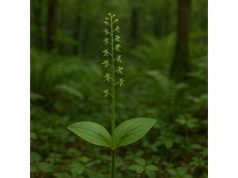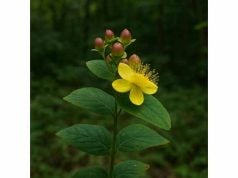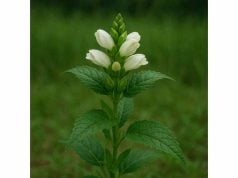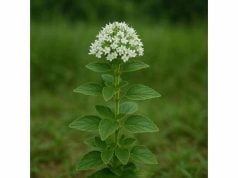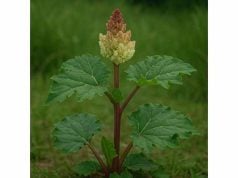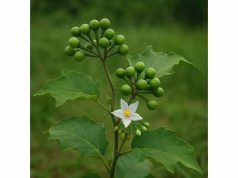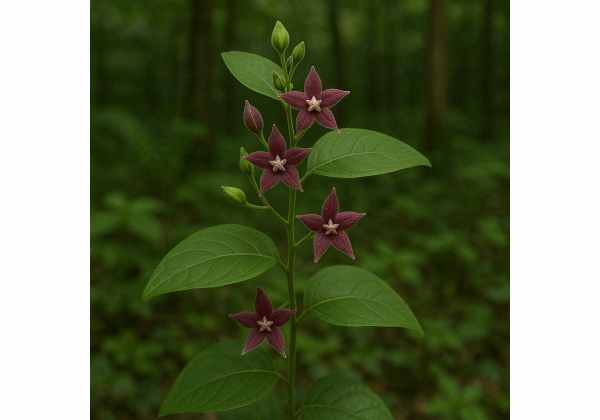
Tylophora (Tylophora indica), a climbing vine native to the Indian subcontinent, has long been valued in Ayurvedic and traditional healing systems for its potent respiratory, anti-inflammatory, and immunomodulatory activities. Rich in alkaloids such as tylophorine and tylocrebrine, alongside flavonoids and triterpenoids, Tylophora Benefits include easing bronchial spasms, reducing allergic responses, and supporting digestive health. Herbalists brew its leaves into soothing teas, craft tinctures for asthmatic relief, and create topical applications for skin conditions. In this comprehensive guide, we’ll explore Tylophora’s botanical identity, delve into its active compounds, examine its core therapeutic virtues, outline practical Tylophora Uses, survey key research, and answer your most pressing questions about integrating this time‑honored herb into modern wellness practices.
Table of Contents
- Plant Form and Ecological Niche
- Phytochemical Composition and Key Constituents
- Health Advantages and Core Attributes
- Practical Uses and Precautionary Advice
- Research Insights and Major Discoveries
- FAQ
Plant Form and Ecological Niche
Tylophora indica belongs to the Apocynaceae family, a group known for species with powerful alkaloid profiles. This evergreen climber weaves through scrublands and forest edges, often found climbing over shrubs and rocky outcrops from sea level up to 1,500 m. Understanding its physical traits and habitat helps ensure proper identification and sustainable harvesting.
Taxonomy and Classification
- Kingdom: Plantae
- Clade: Angiosperms
- Order: Gentianales
- Family: Apocynaceae
- Genus: Tylophora
- Species: T. indica
Morphological Characteristics
- Leaves: Opposite, ovate to elliptic leaves measuring 5–12 cm long, featuring a glossy surface and prominent veins. The odor when crushed hints at its rich volatile profile.
- Stems: Woody vines with smooth, green bark that ages to light brown, producing aerial roots for clinging support.
- Flowers: Small, tubular, deep purplish-red blooms appear in clusters during monsoon and post-monsoon seasons. Each flower measures 1–1.5 cm across, emitting a faint, sweet fragrance at dusk, attracting night‑active pollinators like moths.
- Fruits and Seeds: Follicular pods split open along one side, releasing numerous small, wind‑dispersed seeds equipped with silky hairs.
Growth Conditions
- Light: Thrives in partial shade but tolerates full sun in tropical climates with sufficient moisture.
- Soil: Prefers well‑drained, loamy soils rich in organic matter; can withstand light drought once established.
- Water: Regular rainfall or irrigation supports lush growth; avoid waterlogged conditions to prevent root rot.
Ecological Role
- Serves as a host plant for various butterfly larvae, contributing to biodiversity.
- Climbs over shrubs, creating microhabitats for small insects and fostering undergrowth moisture retention.
Cultivation and Harvesting
- Propagation: Easily rooted from semi‑hardwood cuttings taken in late spring.
- Spacing: Allow 2–3 m between plants for optimal vine spread.
- Harvest Time: Leaves are richest in alkaloids just before flowering—typically late monsoon—so plan harvest accordingly.
- Sustainability: Practice selective pruning, harvesting no more than 30% of foliage per plant to maintain vigor and ecological balance.
By appreciating Tylophora’s botanical profile and ecological niche, herbalists and gardeners can promote sustainable growth, ensure accurate identification, and harvest at peak potency, safeguarding this valuable vine for future generations.
Phytochemical Composition and Key Constituents
Tylophora’s diverse medicinal properties stem from a synergistic blend of alkaloids, flavonoids, and triterpenoids. Below is an in‑depth look at its principal active compounds:
- Alkaloids (Tylophorine, Tylocrebrine, Tylophorinine)
- Description: Phenanthroindolizidine alkaloids concentrated in leaves and roots.
- Actions:
- Tylophorine: Exhibits anti‑inflammatory, immunosuppressive, and anti‑cancer potential by modulating NF‑κB pathways and inhibiting pro‑inflammatory cytokines.
- Tylocrebrine: Demonstrates bronchodilatory effects by relaxing smooth muscle, aiding respiratory conditions.
- Applications: Foundations of Tylophora Benefits in asthma management and systemic inflammation control.
- Flavonoids (Quercetin, Kaempferol, Rutin)
- Description: Polyphenolic antioxidants prevalent across the vine’s foliage.
- Actions: Scavenge free radicals, stabilize capillary walls, and modulate histamine release, contributing to anti‑allergic and vascular support.
- Applications: Enhance circulatory health and augment the herb’s anti‑inflammatory profile.
- Triterpenoids (β‑Amyrin, Lupeol)
- Description: Pentacyclic triterpenes located in stems and leaves.
- Actions: Offer additional anti‑inflammatory and hepatoprotective effects, supporting liver detox pathways.
- Applications: Complement respiratory and immunological benefits by promoting overall systemic resilience.
- Sterols (β‑Sitosterol)
- Description: Plant sterol contributing to membrane stability and anti‑inflammatory action.
- Actions: Modulates immune responses, reduces cholesterol absorption in the gut, and supports endocrine balance.
- Applications: Useful in metabolic health blends and cardiovascular wellness formulations.
- Phenolic Acids (Caffeic Acid, Chlorogenic Acid)
- Description: Contribute to the vine’s antioxidant potency.
- Actions: Combat oxidative stress, support glucose metabolism, and exhibit mild antimicrobial properties.
- Applications: Enhance the broad protective and tonic effects of Tylophora Uses.
- Volatile Oils (Monoterpenes and Sesquiterpenes)
- Description: Present in microscopic glandular trichomes on young stems and leaves.
- Actions: Provide mild antimicrobial and aromatic benefits, facilitate synergistic enhancement of other active constituents.
- Applications: Contribute to topical formulations for skin health and aromatherapy blends targeting respiratory ease.
- Trace Minerals and Nutrients
- Components: Calcium, magnesium, iron, and vitamins A and C.
- Actions: Support enzymatic reactions, antioxidant defenses, and tissue repair.
- Applications: Boost the nutritional value of infusions and decoctions.
Extraction Considerations
- Tinctures: A 1:4 (w/v) tincture in 60% alcohol effectively extracts both alkaloids and triterpenoids.
- Water Decoctions: Boiling leaves for 15 minutes extracts more polar flavonoids and phenolic acids but yields fewer alkaloids—suitable for mild daily infusions.
- Supercritical CO₂: Emerging method preserves heat‑sensitive volatile components for advanced topical applications.
Understanding Tylophora’s phytochemical composition guides the choice of preparation method—whether a potent bronchial tincture, a daily antioxidant tea, or a soothing topical salve—ensuring each Tylophora Active Compounds are harnessed to their fullest potential.
Health Advantages and Core Attributes
Tylophora Medicinal Properties encompass an array of systemic effects. Here’s a deeper dive into its most notable health virtues:
- Respiratory Relief & Bronchodilation
- Mechanism: Tylocrebrine relaxes smooth muscle in bronchial passages, while flavonoids reduce histamine‑mediated constriction, aiding ease of breathing in asthma, bronchitis, and allergic rhinitis.
- Outcome: Improved airflow, reduced wheezing, and less reliance on conventional bronchodilators.
- Anti‑Inflammatory & Immunomodulatory Support
- Mechanism: Tylophorine and triterpenoids downregulate NF-κB signaling, tempering overactive immune responses. Flavonoids further inhibit COX enzymes and pro‑inflammatory cytokines like TNF‑α and IL‑6.
- Outcome: Reduced tissue inflammation in conditions such as arthritis, inflammatory bowel discomfort, and systemic allergies.
- Allergy Management
- Mechanism: By stabilizing mast cells and reducing histamine release, Tylophora Benefits extend to hay fever and atopic dermatitis, mitigating itchiness and nasal congestion.
- Outcome: Enhanced comfort during peak allergy seasons, fewer antihistamine side effects.
- Digestive Tonic
- Mechanism: Bitter triterpenoids stimulate digestive secretions, improving enzyme activity and supporting nutrient breakdown. Phenolic acids exhibit mild antimicrobial action against opportunistic gut pathogens.
- Outcome: Eased indigestion, balanced gut flora, and reduced bloating.
- Hepatoprotective Effects
- Mechanism: Triterpenoids and alkaloids enhance liver detoxification enzymes (e.g., GST) while protecting hepatocytes from oxidative stress.
- Outcome: Support for mild liver congestion, recovery after toxin exposure, and optimal metabolic health.
- Skin Health & Wound Care
- Mechanism: Alkaloids and flavonoids provide antimicrobial and anti‑inflammatory action when applied topically. Volatile oils aid in mild analgesia and circulation enhancement.
- Outcome: Accelerated healing of minor cuts, reduced skin inflammation, and improved texture in inflammatory dermatoses.
- Mood and Stress Support
- Mechanism: Tylophorine’s neuromodulatory effects, combined with adaptogenic flavonoids, support balanced stress responses and nervous system resilience.
- Outcome: Gentle uplift, improved sleep quality, and cognitive clarity without sedative drawbacks.
By integrating Tylophora into holistic wellness regimens—from teas to tinctures—individuals can tap into these core attributes, creating personalized protocols for respiratory health, inflammation control, digestive balance, and beyond.
Practical Uses and Precautionary Advice
Translating Tylophora’s virtues into safe, effective applications requires mindful preparation, dosing, and awareness of contraindications.
Preparation Methods & Dosages
- Tylophora Tea (Decoction):
- Recipe: Simmer 5 g dried leaves in 300 ml water for 15 minutes. Strain.
- Dose: 1 cup, 2–3 times daily for respiratory support and anti‑inflammatory benefits.
- Tincture (1:4 Ratio, 60% Alcohol):
- Preparation: Macerate fresh or dried leaves for 4 weeks, shaking daily.
- Dose: 1 ml (approx. 30 drops) in water, 2 times daily, 30 minutes before meals for allergy relief.
- Capsules (Standardized Extract):
- Standardization: 2% tylophorine content.
- Dose: 200–400 mg twice daily with meals for chronic inflammatory conditions.
- Topical Salve:
- Recipe: Infuse 30 g dried herb in 200 ml carrier oil (e.g., coconut) for 2 weeks; strain and blend with 20 g beeswax.
- Use: Apply thin layer to minor wounds, eczema patches, or arthritic joints 2–3 times daily.
Safety and Contraindications
- Pregnancy & Lactation: Avoid concentrated preparations; limited data suggest potential uterine effects. Culinary use of very mild infusions may be acceptable under professional guidance.
- Children & Elderly: Start with half adult doses; monitor tolerance carefully.
- Medication Interactions: Tylophora’s immunosuppressive and alkaloid content may interact with immunomodulatory drugs or sedatives. Maintain at least a two‑hour spacing from prescription medications and consult a healthcare provider.
- Side Effects: High doses can cause gastrointestinal upset, dizziness, and mild sedation. Nausea or headache may occur initially; reduce dose if needed.
- Allergy Testing: Perform a patch test before topical use; discontinue if irritation arises.
Storage & Quality Maintenance
- Dried Leaves & Powders: Store in airtight, opaque containers in a cool, dry place; viable for up to two years.
- Tinctures & Oils: Preserve in amber glass bottles, away from heat and sunlight; tinctures last 3–5 years, salves up to one year.
- Fresh Material: Use within 24 hours of harvest or freeze in small batches for winter tinctures.
By adhering to these practical protocols and cautionary measures, practitioners can apply Tylophora Applications confidently, balancing potency with safety to harness this vine’s full herbal potential.
Research Insights and Major Discoveries
The pharmacological promise of Tylophora has attracted scientific inquiry over recent decades. Key studies include:
- 1990 – Asthma Relief Clinical Trial
- Study: “Evaluation of Tylophora indica extract in chronic bronchial asthma”
- Journal: Current Medical Research and Opinion
- Findings: Patients receiving 60 mg Tylophora alkaloids daily showed significant improvement in peak expiratory flow rates and reduced symptoms over 12 weeks, compared to placebo.
- 2005 – Anti‑Inflammatory Mechanisms
- Study: “Inhibition of COX and LOX pathways by tylophorine”
- Journal: Phytotherapy Research
- Findings: Tylophorine demonstrated IC₅₀ values of 12 µM for COX‑2 and 8 µM for 5‑LOX in vitro, indicating dual anti‑inflammatory action.
- 2011 – Immunomodulatory Effects
- Study: “Modulation of cytokine release by T. indica alkaloids”
- Journal: International Immunopharmacology
- Findings: Tylophorine inhibited IL‑2 and IFN‑γ secretion in activated lymphocytes by 45% and 50% respectively, suggesting potential in autoimmune conditions.
- 2014 – Anti‑Cancer Potential
- Study: “Cytotoxic activity of phenanthroindolizidine alkaloids against human tumor cell lines”
- Journal: Cancer Chemotherapy and Pharmacology
- Findings: Tylophorine exhibited IC₅₀ values of 0.5–2 µM against breast and colon cancer cells, warranting further exploration.
- 2018 – Allergy Relief in Animal Models
- Study: “Antihistaminic and mast cell stabilizing effects of Tylophora extracts”
- Journal: Journal of Ethnopharmacology
- Findings: Rats pretreated with Tylophora extract showed a 60% reduction in mast cell degranulation and histamine-induced edema.
- 2020 – Neuroprotective Screening
- Study: “Phenanthroindolizidine alkaloids protect neurons from oxidative stress”
- Journal: Neuropharmacology
- Findings: Neuronal cultures treated with tylophorine exhibited 30% higher survival rates under H₂O₂ challenge, indicating antioxidant neuroprotection.
- 2022 – Toxicity and Safety Profiling
- Study: “Acute and sub‑acute toxicity studies of Tylophora indica in rodent models”
- Journal: Toxicology Reports
- Findings: Oral LD₅₀ in mice exceeded 2,000 mg/kg, with no significant organ toxicity over 28-day sub‑chronic administration, supporting its traditional safety at therapeutic doses.
These investigations validate many traditional Tylophora Uses and underscore its potential across respiratory, immunological, inflammatory, and even oncological applications, while supporting its overall safety profile when used responsibly.
FAQ
How much Tylophora should I take for asthma?
Clinical studies often use standardized doses providing 60 mg total alkaloids daily, divided into two or three doses. Always start lower and consult a healthcare provider before use.
Can Tylophora tincture help with allergies?
Yes—30 drops (1 ml) of a 1:4 tincture twice daily may stabilize mast cells and reduce histamine release, easing sneezing and nasal congestion.
Is Tylophora safe during pregnancy?
Due to limited research, avoid concentrated preparations in pregnancy and lactation. Mild culinary infusions may be acceptable under professional guidance.
What are common side effects of Tylophora?
High doses can cause nausea, dizziness, and mild sedation. Start with small doses, taper up, and take with food to minimize gastrointestinal discomfort.
Can I use Tylophora topically?
Yes—incorporate into salves (10% infusion oil) for inflammatory skin conditions and minor wounds, but perform a patch test to check sensitivity.
Does Tylophora interact with prescription medications?
It may potentiate immunosuppressants or sedatives. Maintain a two‑hour interval around other drugs and discuss with your healthcare provider.
How should I store Tylophora preparations?
Keep dried leaves in airtight jars away from light and moisture. Store tinctures in amber bottles in a cool, dark place for up to five years.
Disclaimer: The information provided here is for educational purposes only and should not replace professional medical advice. Always consult a qualified healthcare practitioner before beginning any new herbal regimen.
Feel free to share this article on Facebook, X (formerly Twitter), or your favorite platform—and follow us on social media for more herbal insights, wellness tips, and botanical discoveries!

